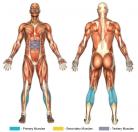Donkey Calf Raises (Machine)
- Set the lower back/hip pad at the correct height, then add the desired amount of weight. (The correct height is the height whereby there is a slight bend in your knees when your lower back/hip is in contact with the pad.)
- Position the balls of your feet on the feet plate (see "Further Clarification for an explanation of how to target different aspects of the calf muscles) with your heels hanging off (beyond the feet plate) and your legs extended, lean your torso forward, and place your forearms on the arm pads.
- Press with your feet (plantar flexion) until your calves are fully flexed, keeping your legs straight at the knees, while exhaling throughout the positive aspect of the movement.
- Lower until your heels are lower than the feet plate (a deep stretch will be felt in the calves), and inhale throughout the (negative) aspect of the movement.
- Repeat steps 3-4 for as many repetitions as are desired.
Of all the calf muscles, donkey calf raises places the most focus on the gastrocnemius.
The calves are usually considered to be the most arduous muscle of the body to develop because they are accustomed to being worked constantly by the mere act of ambulating from place to place. The calves are capable of performing a notably high quantity of work. Getting results in calf strength, definition, or mass will, for most, require mental fortitude and strong, unwavering volition.
If building calf mass is the goal, then lifting with heavy weights is almost unequivocally required. Likewise, if building calf endurance is the goal, then lifting with high repetitions is almost absolutely required.
In theory, the feet can be positioned in different ways to change the focus of stress on the calf muscles. By pointing the feet outwards it is possible to isolate the inner calf (medial gastrocnemius) and, conversely, by pointing the feet inwards it is possible to isolate the outer calf (lateral gastrocnemius). For most, it will take practice to achieve this result, even with proper foot placement. Separating the stress put on the gastrocnemius from the soleus is much easier to accomplish. (e.g. Standing calf raises will work the gastrocnemius more, while seated calf raises will work the soleus more).
The weight should be such that you can raise up fully onto the balls of your feet for the majority of the repetitions. Once your calves are exhausted, finish you set by executing partial repetitions. The muscular burn you experience will likely be intense, but if you want results it the price that must be paid.
Technically this exercise can be done without a donkey calf raise machine. Simply have a training partner straddle your hips (as if he/she is riding you like a horse, donkey, camel, etc.). Yes, this method has a certain ridiculousness to it, and has great potential for awkwardness (depending on your level of comfort with your training partner, and in general), but it is nonetheless quite effective.





